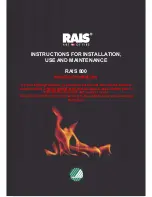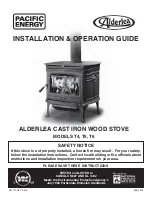
IN 1830 Charles Portway built a stove to heat his ironmongery shop at Halstead in Essex. It was
so good that his neighbours started asking for them. Mr Portway had done something completely
new - designed his stoves right from the start to give out the maximum heat from the minimum
fuel, so that he is known as
"The Founding Father of Energy Efficiency".
These stoves are
still made in Britain by the direct successors of the company he established.
Building rules and regulations are available at www.soliftec.com
INSTALLING
a stove is a 'controlled service', the law expects that
it is either supervised by a qualified installer or that the building
inspector is informed. Check with your local authority.
ASBESTOS:
Your stove does not contain asbestos, but take care
to avoid disturbing asbestos in an old installation.
WEIGHT:
Your stove is heavy - take great care when moving it
and ensure that the intended fireplace can support the weight-
consider fitting a load distributing plate.
YOUR CHIMNEY,
by becoming warm, makes the gas inside it
rise, pulling fresh air into the stove to make it work. It must:
●Generate a draught in use of at least 12Pa (0.05ins wg)
●Be capable of withstanding the temperatures generated.
●Be absolutely incapable of leaking fumes into the dwelling
This may commonly be achieved by it:
●Being at least 5m high.
●Terminating at least 1m above any roof ridge.
●Having an internal cross-section equivalent to not less than
150mm dia and never more than 0.14m² (eg 375 x 375mm)
●Being free from even the slightest crack or source of leakage.
●Having no bends sharper than 45º.
●Being swept and entirely free of obstructions
●Being connected only to this one appliance.
●Being of thick masonry or otherwise adequately insulated.
●Conforming to local building regulations.
Special rules apply where the flue passes through timber, thatch or
other vulnerable materials- take specialist advice.
Although it is possible to access the chimney for cleaning through
the fire with the throat plate removed, fit hatches to provide access
if needed.
YOUR FIREPLACE:
Stoves become VERY hot, the setting must
be made entirely of durable fireproof materials. take care to
observe the safe distances to combustibles shown on the front
page.
AIR SUPPLY:
Your stove needs air to breathe - if air supply is
simply by way of a permanent fresh air supply into the room where
the stove is installed, it must equal 550mm² for each kW of
nominal output. An extractor fan, or another fuel-using appliance in
the same building, can remove this air.
The supply tube and outside grille in
the
BFM Safety Air Supply kit
,
available as an extra, provides the
correct fresh air for combustion and
ventilation from outside, without
draughts across the room, without
need for further vents and meets the
complete requirements of UK and RoI
Building Regulations.
FITTING
Adjusting the thermostat: Check the thermostat on the
side of the stove before fitting!
With the fire cold, the
thermostat sensor in place in its hole towards the rear top of
the boiler and the thermostat control turned to '1' the air
closure 'damper' plate should be approximately 7 mm open.
Fasten the flue outlet to the top of the stove and seal to the
chimney using a
short
(up to about 0.5m) length of
uninsulated pipe. Two possible ways of doing this are shown.
Whichever method is used it is
imperative
that the route for
gases from the stove to the chimney terminal is
completely
air-tight; even the tiniest gap or crack can spoil the updraught.
Seal all joins with fireproof cement and/or heatproof rope.
HEATING SYSTEM DESIGN
This appliance is for use with an open-vented water heating circuit at a maximum pressure of 1.5 Bar, equivalent to a static head of 15
metres (50ft). Suggested circuit designs are given on a separate sheet.
IMPORTANT! CHECK THE INSTALLATION !
Once installed, light the fire, demonstrate it to the householder and check that:
1) It burns controllably and does not emit fumes to the room
2) The route for gases from the stove to the chimney terminal is completely airtight, unobstructed and able to be swept . (access
hatches may be required.)
3)
The installer has completed the notice at the beginning of this document, demonstrated the method of lighting, control and cleaning, and
pointed out the safety requirements to the householder.
4) The entire fireplace construction is of durable fireproof materials.
5) The flue presents a draught in use of at least 12Pa
6) A CO alarm is fitted
7) The water system has provision to dissipate or store surplus heat, can accommodate boiling, and has means to minimise the
circulation of cool water through the boiler.
2
THIS APPLIANCE BECOMES EXTREMELY HOT
AND CAN PRODUCE POISONOUS GASES.
A fire-guard should be used if children or the infirm are
present. The installer is required to EXACTLY follow
these instructions and to completely comply with all
local, national and international standards.
Through
steel or concrete
closure plate
(with cleaning door) into old, oversized,
chimney. Steel sealing collar.
45º top outlet sleeved
through wall into external
insulated flue. Cleaning
hatches on bends.






















